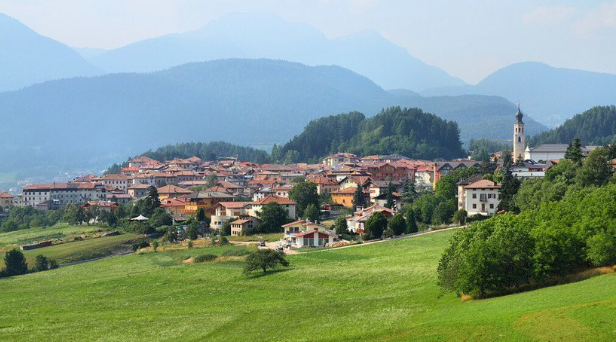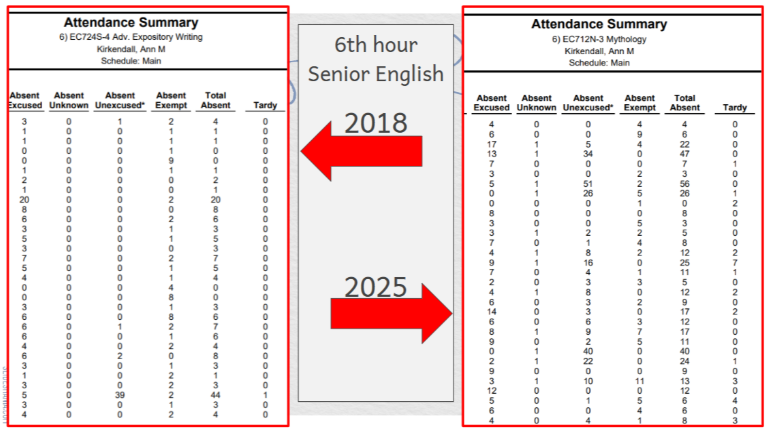What is school like in Italy?
The view of the northern Italian countryside, where Zani lives.
October 28, 2022
Exchange student Soph. Alissa Zani walked down the mountainous streets of her small town in northern Italy to catch the public bus for a ride to school. Her town is located in the valley of the Dolomite Mountains near Trento. With a population of only 1,400, it is not big enough for a high school, so she must go to a school that is an hour long bus ride away. As she stared out the window at the sun peaking over the horizon, illuminating the snow-capped mountain peaks and narrow, winding roads, she mentally prepared herself for a taxing day of school ahead.
Zani attends a scientific school. “In Italy there are different types of high schools.
Scientific high schools prepare you to enroll in university, while professional and technical schools allow you to go directly into the workforce,” Zani said. Before entering an upper secondary school, students must choose a subject in which to specialize; arts, classical studies, languages, music and dance, sciences, or humanities. “High school lasts for 5 years, from age 14 to 19,” says Zani.
Technical institutes prepare students for both university studies and a career. Most technical schools prepare students for careers in agriculture, industry, or commerce. Students attend professional institutes for 3-5 years for a vocational qualification. If a student wishes to receive their secondary school diploma and continue on to university, they must pass a written and oral exam.
Scientific high schools focus on physics, chemistry and natural science as well as Latin and one modern language. Zani takes 12 classes that are the same for all 5 years of high school. She takes philosophy, Italian, history, art history, Latin, physical education, physics, biology, chemistry, math, religion, and English. “We have 6 classes each day and each class is 50 minutes long.” She has different classes each day. For example, on Mondays she has one hour of math, two hours of physics, two hours of philosophy and one hour of science.
The school day begins at 7:50am and ends at 1 in the afternoon, except on Wednesday’s, Friday’s and Saturday’s, when school ends at 12:10. Yes, students have to go to school on Saturday’s, but that’s the tradeoff for having a shorter school day. Because school ends at 1, students do not have a lunch period at school, instead they eat when they get home.
“School is very education focused, so we don’t have any after school sports or clubs. If you want to play a sport, you have to play on a team outside of school and you play one sport for the whole year. But most people don’t have time to play sports, I never do because I have to study for at least three hours after school every day,” said Zani.
Unlike in America, teachers travel between classrooms instead of students going to different classrooms and different teachers for each class. “I’ve had the same 11 kids in my class for all five years of high school,” Zani said. Being with the same group of students for all of high school bonds them in a way that we don’t get to experience here, where we have different students in each class, and may not get to see our friends at all during the day.
The relationship between students and teachers in Italy is very different than in America. In Italy, teachers are strictly your teacher and they do not make any attempt to get to know you outside of the classroom. Students are much more respectful of their teachers; they must stand when their teacher enters the classroom and they do not talk when the teacher is speaking. There is no group work or projects, instead the teachers lecture for the entire class period and the students take notes.
Another big difference between the education system in Italy and the United States is the grading system. Instead of using letter grades, Italy grades on a scale of 1-10, with 1 being the lowest score and 10 the highest. The minimum passing grade is a 6, 7 is a good score, 8 is a very good score, and 9-10 are excellent scores, although teachers rarely give 10’s. Additionally, teachers do not assign homework or quizzes, but there is one big test in each subject at the end of the month. These tests require a lot of preparation because they can cover anything that has been taught during the course of that month.
Her favorite part about coming to the United States so far is that, “People are less judgmental, they don’t care so much about what you’re wearing and there is less pressure to always dress nice.” In Italy, students dress as what we consider “fancy”, every day, meaning they would never be caught in pajamas or athletic clothing at school. “We don’t have school dances or spirit weeks in Italy, so going to homecoming was a very new experience for me,” said Zani, smiling.
“I miss my family and friends a lot but I’m very grateful for the opportunity to come to America and experience a new culture and way of life,” says Zani.




